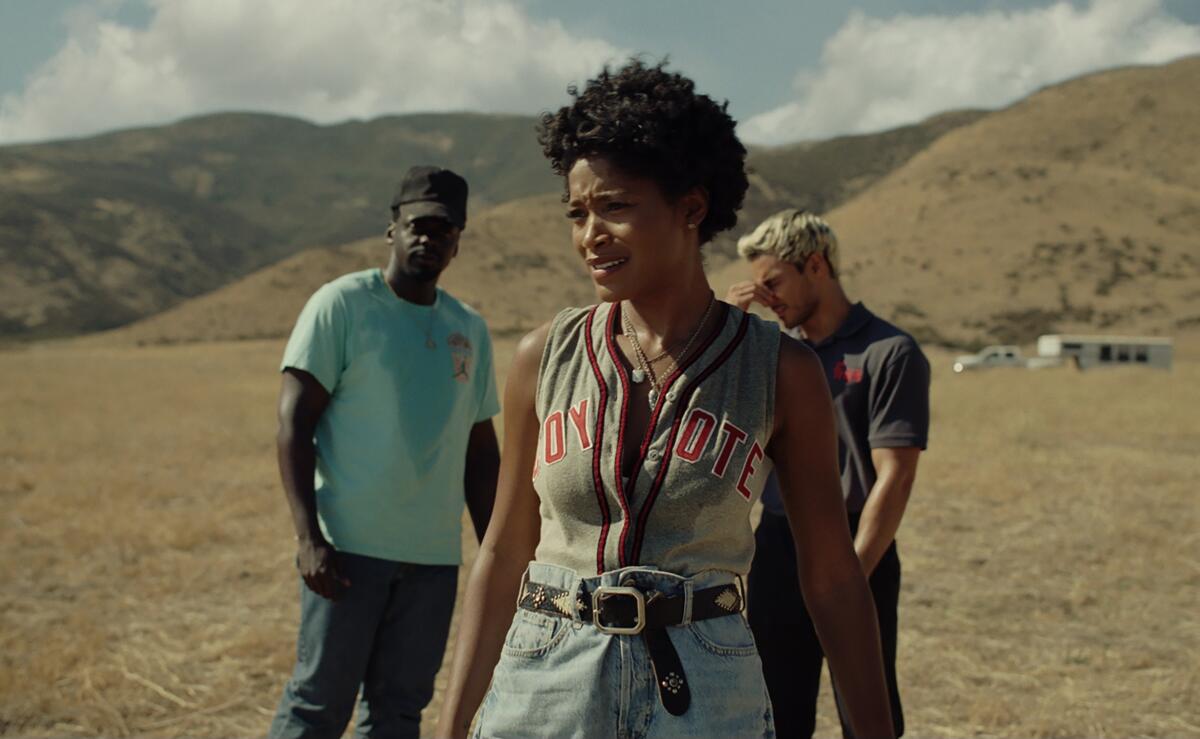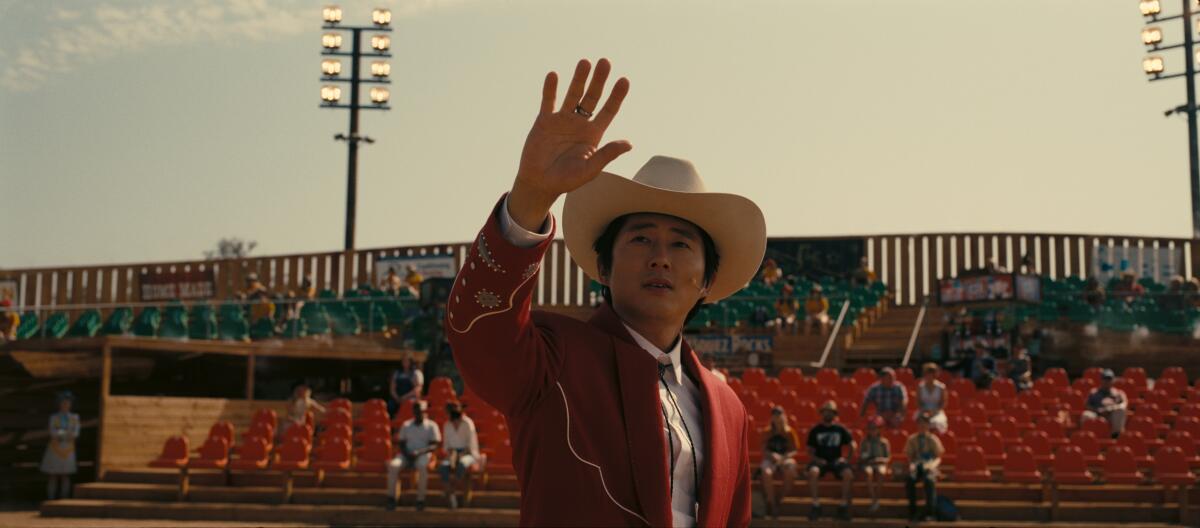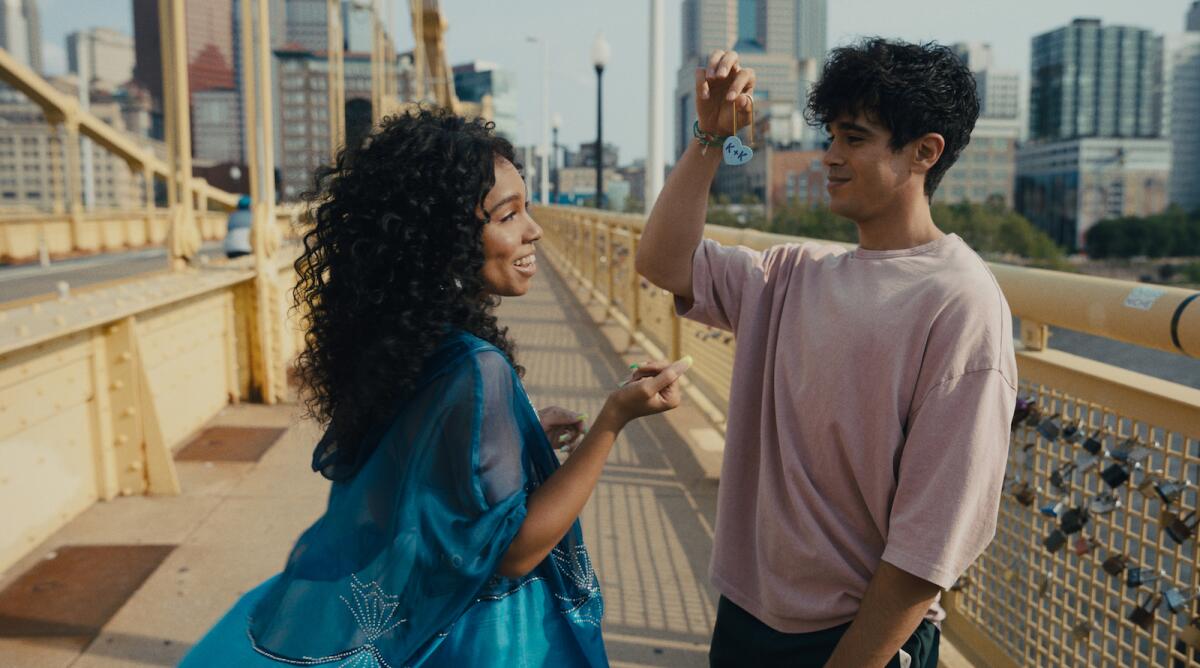Explore the many mysteries of Jordan Peele’s ‘Nope’

Hello! I’m Mark Olsen. Welcome to another edition of your regular field guide to a world of Only Good Movies.
Only good movies
Get the Indie Focus newsletter, Mark Olsen's weekly guide to the world of cinema.
You may occasionally receive promotional content from the Los Angeles Times.
The “Irma Vep” finale. One of the low-key delights of this summer has been Olivier Assayas’ adaptation of his 1996 movie, “Irma Vep,” into a streaming series of the same name. The show, starring Alicia Vikander as a film star appearing in a director’s remake of his own movie into a streaming series, has been by turns playfully funny, emotionally vulnerable and mystically enigmatic. Available on HBO and HBO Max, the finale airs Monday.
Justin Chang is writing a critic’s take on the series for next week, and I recently spoke to Assayas about making the move from feature films to a streaming series. “Honestly, in terms of how I write or how I function on a set, I can’t see the difference,” said the director. “‘Irma Vep,’ I shot it with the same crew I work with when I make my films. I have the same people around me. I function in a completely similar way. So I think that I am using the format of TV to give me space, length when I need it for a specific project.”
Hawke, Newman and Woodward. This week, HBO Max also dropped another series that is a much-watch for movie fans. Directed by Ethan Hawke, “The Last Movie Stars” is a six-part documentary on the lives, careers and 50-year marriage of Joanne Woodward and Paul Newman.
I spoke to Hawke about the project, which includes readings by George Clooney as Newman and Laura Linney as Woodward, along with a host of other actors reading as their friends and collaborators, drawing from interviews done for Newman’s unpublished memoir. Hawke said, “What makes their story the most interesting and worth talking about is the breadth and scope of it, is the fact that through their work, you see the ’50s, the ’60s, the ’70s, the ’80s, the ’90s, and the fact that they had this level of sustained excellence for so long. … Each performance in and of itself is very good, but what’s revelatory is the consistency.”
L.A. Times Short Docs. Over the last few months, The Times has been publishing a series of short documentaries, all of which are available to watch online. On Tuesday, July 26, a program of 10 titles will screen at the Laemmle NoHo as part of the L.A. Shorts International Film Festival.
‘Nope’
The latest film from writer-director Jordan Peele, “Nope” has a purposefully complicated story, a horror/sci-fi/western combo that will not be detailed here. Rather, let it simply be said that the movie involves a brother and sister (Daniel Kaluuya and Keke Palmer) who are fighting for their livelihood and then their lives. Steven Yeun also stars in the movie, which is in theaters now.
For The Times, Justin Chang wrote, “In some ways, then, ‘Nope’ is a movie about the challenge of getting the perfect shot, an aim that Peele shares on a practical and artistic level — there’s no shortage of well-framed, jaw-dropping images — even as he cautions against it in the abstract. … In a sense, Peele wants to use a Hollywood genre template to mount a critique of Hollywood barbarism, to lay bare the callousness of an industry that grinds dreams into dust and exacts a lot of unseen collateral damage. And because the audience plays its part in this vicious cycle, Peele means to complicate the very act of watching, to suggest that it can have its moral costs as well as its undeniable pleasures. That’s one reason he implies rather than embraces the violence of his story’s darkest moments, turning the unspeakable into the unshowable.”
Christi Carras created a roundup of the most memorable quotes from Keke Palmer while she has been out promoting “Nope” — and there have been many.
For Rolling Stone, K. Austin Collins wrote, “‘Nope’ may be a horror movie in which the most damning thing you can do is to look — but the key to the movie’s conceit is in the irony in wanting to be seen: in which the Black descendants of a man whose name has been lost to movie history find themselves eager to be handed the reins of their own story and given a chance to tell it themselves, for once. … Midway through, ‘Nope’ dials back on the heightened frights of its horror to become something else. It becomes a story of invasion — not just of the extraterrestrial kind, but of the land-born, territorially offensive kind. It becomes a movie about protecting the homestead from the most invasive species of all: other people. It becomes a Western.”
For the Ringer, Adam Nayman wrote, “It’s a thin line between profundity and pretentiousness, and by framing ‘Nope’ with a Bible verse disparaging the voyeurism and exploitation of popular culture — ‘I will pelt you with filth, treat you with contempt, and make you a spectacle’ — Peele perhaps falls on the wrong side of that boundary. Still, there’s something admirable about a director who thinks enough of his audience to confront (and even confuse) them instead of just cranking out virtuoso set pieces.”
For Vox, Alissa Wilkinson wrote, “‘Nope’ is a bloody, creepy UFO movie, unexpectedly gross in spots, with several different ideas knocking around in its head. Since the relatively straightforward ‘Get Out,’ Peele’s work has moved away from simple explanation and toward discomfiting vibes, and that’s to its credit. But that means audiences have to lean in and work harder, and have to be okay with mystery. That helps explain why some viewers may come away dissatisfied. TV and movies over the past several decades have coaxed us to expect explanations and puzzle boxes in our entertainment, and to be annoyed when creators refuse to reveal the trick at the end of the show. But Peele is happy to leave some things to our imaginations.”

Enjoying this newsletter? Consider subscribing to the Los Angeles Times
Your support helps us deliver the news that matters most. Become a subscriber.
‘The Gray Man’
Directed by Joe Russo and Anthony Russo, action-adventure espionage thriller “The Gray Man” is adapted from a novel by Mark Greaney with a screenplay credited to Joe Russo, Christopher Markus and Stephen McFeely. Ryan Gosling is a criminal turned government assassin with the code name Sierra Six, who must square off against a rival, Lloyd Hansen (Chris Evans). The cast also includes Ana de Armas, Billy Bob Thornton, Alfre Woodard, Regé-Jean Page, Jessica Henwick, Julia Butters and Indian star Dhanush. The film is in theaters now and streaming on Netflix.
For The Times, Justin Chang wrote, “It’s such a synthetic, soulless bundle of goods that it barely feels touched by human hands. Full of smirking one-liners, blink-and-you-miss-’em international locations and acts of gratuitously unpleasant (if more implied than seen) violence, it’s basically Netflix Winding Refn; it’s globe-trotting comic nihilism for the whole streaming-loving family. … It also has the murky, heavily processed digital look of more than a few so-called Netflix originals, the ones that come flaunting a blockbuster price tag yet somehow still look indefensibly cut-rate on a proper movie screen.”
For the New York Times, Amy Nicholson wrote that the writers “created a screenplay that is an assault of amusement; a barrage of bullets and one-liners. The razzle-dazzle does quite a bit to invigorate what is at its core a routine tale. … Yet the frenzy is also distracting to the brink of self-sabotage. An early fight scene is jazzed with so many spliced-in shots of smoke and fireworks that one worries the Russos are insecure about Gosling’s ability to execute his stunts. Thankfully, the film grows in confidence and inventiveness. In later sequences, Six doggedly rescues himself from a tumbling plane, a trap door and a set of handcuffs.”
For Vulture, Alison Willmore mused that a sizable portion of the film’s reported $200-million budget went to paying its stars, further adding, “What’s left has been used to make something perfectly serviceable to leave on in the background while noodling on your phone, and I mean that as a compliment. Netflix’s previous attempt at an extravagantly priced star-driven action movie, ‘Red Notice,’ felt like it was written by an AI and performed in front of green screens without ever requiring its stars to be in the same room. ‘The Gray Man’ at least feels like a middling studio movie that wasn’t worth catching in theaters but that would comfortably fill an afternoon if you stumbled on it airing on cable.”

‘Anything’s Possible’
The feature directorial debut of Billy Porter from a script by written by Ximena García Lecuona, “Anything’s Possible” is a joyful, YA rom-com. Set in Porter’s native Pittsburgh, the story finds Kelsa (Eva Reign), a Black transgender high school student, falling for her best friend’s crush, Khal (Abubakr Ali). The film is streaming now on Amazon Prime Video.
For The Times, Robert Daniels wrote, “Kelsa and Khal are a winning duo with dynamite chemistry. They move around each other with a palpable physical freedom that softly kindles romance. The twinkle in their eyes, flashing above their knowing smiles, is the kind of awkward teenage swooning made for comfort viewing. … Porter pulls two fantastic, lived-in performances from Ali and Reign as both demonstrate their potential to make the rom-com genre a permanent, hearty meal in their prospective careers.”
Jen Yamato spoke to Porter for a story that will be publishing soon. On what made him want to step behind the camera, Porter said, “Well, the queerness, the joy, the celebration of being queer, the celebration of being othered. I had just come off ‘Pose,’ which really was about a disenfranchised community, a chosen family who choose love and who choose joy in the midst of unthinkable trauma. When we think about queer stories in particular, these days, the trans story — the Black trans story — so much of it is about the trauma. And I was so moved that this was not about the trauma. It’s not a coming-out trans story. It was about, what happens next? What happens after I’m trans? We don’t see a lot of that, especially in the teenage space.”
For the New York Times, Kyle Turner wrote, “The movie gets bogged down in contradiction, like its protagonist: Uncertain of how central its identity politics and their impact should be, it wants its stakes to be high enough to be a believable teen watch, but it also just wants to let the human quality of its story shine. Unlike its lead characters, ‘Anything’s Possible’ never quite figures out if it wants to be distinctive or just another kid at school.”
For the Hollywood Reporter, Lovia Gyarkye wrote, “Kelsa and Khal’s dates shield them from public scrutiny and jealous actors. They galavant through Pittsburgh, going to the Phipps Conservatory and Botanical Garden and visiting art galleries. Through their eyes, the city comes alive, ‘Anything’s Possible’ doubling as a love letter to Porter’s hometown. Porter’s direction is particularly sharp in these scenes. Kelsa and Khal’s stolen glances and body language, coupled with Khal’s playful impersonation of David Attenborough and Kelsa’s gentle teasing, texture the pair’s relationship with youthful energy and lust. The ‘Pose’ star has previously directed theater, but ‘Anything’s Possible’ is his first venture into film. One hopes it won’t be his last.”

Only good movies
Get the Indie Focus newsletter, Mark Olsen's weekly guide to the world of cinema.
You may occasionally receive promotional content from the Los Angeles Times.




